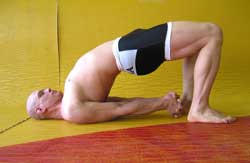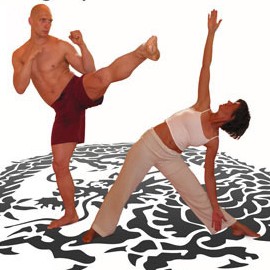“I was relaxed doing yoga and this gave me the equilibrium to fight well”
– Wallid Ismael commenting on preparing, and winning, his Jiu-jitsu match against Royce Gracie, December 1998
Introduction
You don’t have to look far to find yoga in grappling. Many of the top competitors and teachers in Brazilian jiu-jitsu practice some form of yoga to give them an edge over their opponents. Rickson and Royler Gracie, Murilo Bustamante, Vitor Belfort, Fernando “Margarida” Pontes, Ricardo Liborio, Wallid Ismael, and Roger Machado have all included yoga in their training.
Even non-Brazilians have realized that there is something to yoga, especially when it comes to grappling. BJ Penn, UFC prodigy and the first non-Brazilian to win the world championships at the black belt level practises some form of yoga daily. Dan Inosanto, world-renowned martial artist makes time to include yoga in his incredibly busy weekly workout schedule. When you realize that Dan Inosanto achieved his BJJ black belt at age 65, it makes you wonder if maybe he is onto something!
Why would all these grappling superstars be interested in something as wishy-washy as yoga? Obviously there must be some concrete benefits to a personal yoga practice, or these elite grapplers wouldn’t be doing it. In this article we are going to explore some of the different areas in which yoga can directly improve your grappling.
Flexibility
Yoga is most known for developing flexibility. Increased flexibility has many advantages on the mat. In the extreme case, some submissions (like ‘gogoplata’, popularized by the human pretzel, Nino Schembri) are much easier to do if you are extremely flexible. While it takes special dedication and extraordinary genetics to become as flexible as Nino Schembri, anybody can become more flexible using yoga.
The approach to increasing flexibility is very sophisticated – I had been stretching in one way or another for 20 years, and was blown away by how much I learned in my first couple of months of yoga. The integration of breathing with stretching, and using the breath to help you go deeper into a stretch, is central to yoga.
Leg, hip and torso flexibility are very useful in dynamic, aggressive grappling. In the closed guard, for example, flexibility helps you climb your legs high on your opponent, threatening him with many dangerous submissions. In the open guard and its many variations flexible legs and hips can make passing the guard a very frustrating experience for your opponent. Flexibility is also very important in escaping pins and submission attempts.
 |
Stephan using the ‘rubber guard’ in sparring. This is a style of guardwork that requires a certain amount of flexibility |
 |
The ‘Hip Opener’ posture, a yoga stretch for the hip that protects the delicate ligaments of the knee. |
In my opinion, the most important areas to focus on for grappling flexibility are the legs and hips. Many people have tight hamstrings, quadriceps and hips. The first two muscle groups are relatively simple to stretch. The hips, on the other hand, are a very large and complex joint with many different muscles and attachments. Flexibility in the hips is very important in grappling, but can also take a long time to achieve. Yoga has many different stretches that challenge the hips in subtly different ways, and can greatly increase hip flexibility.
Core strength and stability
Over the last few years the importance of ‘core stability’ in athletic training and preparation has been increasingly recognized. The ‘core’ refers to the trunk, and core strength comes from the many muscles all around the trunk, some of which are quite deeply buried. A strong core provides body control and allows you to generate maximum power with your arms and legs – it is the foundation upon which the rest of your functional strength is built.
Yoga is the original core stabilizer: one can clearly see that many exercises and techniques of Pilates – another very popular core strengthening regimen – come directly from yoga. Yoga postures are very similar to many of positions that one uses dynamically in grappling. By strengthening the body’s ability to hold these positions in a controlled and safe manner you can then to blast through these position in an all-out dogfight and not injure itself. In addition, yoga tends to strengthen muscles at the limits of their ranges of motion, which is difficult to do with conventional weight training.
 |
Stephan using a bridging motion to escape the mount position |
 |
Holding the ‘Bridge’ pose from yoga, a great way to develop flexibility and core strength at the same time. |
Bridging is a great example of how important core strength is for grappling. This is a multi-joint movement that uses the strength and flexibility of your torso to the max as you arch your body up to the ceiling. The bridging motion is absolutely central to grappling: it is used to escape from pins, to turnover or sweep an opponent and to put power behind an armbar, anklelock and many other submission holds. If you just use the strength of your arms you are unlikely to successfully finish these locks; put the power of a strong core behind the movement and your opponent will tap almost every time!
Core stability is crucial for injury prevention – anyone who has ever felt the pain of a severe back injury will understand what I am talking about. Most physiotherapists approach back injury rehabilitation with a “stretch and strengthen” approach – yoga is a perfect way to stretch and strengthen your central body.
Breath Control
Beginners in a yoga class notice quickly notice the emphasis on breath and breathing. For the grappler, the increased awareness and efficiency of breathing is one of the most unexpected benefits of a yoga program.
Many martial athletes use only a fraction of their lung capacity when breathing. Usually they only use the upper lungs instead of engaging the diaphragm and drawing air into the lower lungs. This results in inefficient oxygen exchange and premature exhaustion.
Researchers at the University of California and elsewhere have studied the effects of yoga on athletic capability. Not surprisingly, studies show that as little as 8 weeks of yoga can lead to significant increases in flexibility and strength. What was surprising, however, was that there were also relatively large increases in lung capacity and VO2 max. In layman’s terms, this means that yoga has been shown to increase endurance!
Some yoga breathing exercises (e.g. “bellows breathing” or bhastrika) focus on using the diaphragm to pump air in and out of the lungs. The forceful inhalations and exhalations of these exercises strengthen the diaphragm and lungs. Would you actually use these breathing techniques during sparring or competition? Probably not, but think of them as the equivalent of doing pushups for the lungs. Just as you wouldn’t drop to the sidewalk and do pushups in a self-defence situation you wouldn’t use these exercises while sparring. Pushups strengthen the arms for punching; breathing exercises strengthen the lungs for breathing. Learn to utilize the capacity of your entire lungs and watch your endurance increase.
Conscious breathing is also very useful in dealing with for stressful situations. Try to remember the last time you were startled: chances are pretty good that you held your breath or at least breathed very shallowly. The practice of yoga can bring an element of consciousness into your breathing, making it easier for you to recognize when you are holding your breath while under stress. Both holding one’s breath and hyperventilation can lead to panic. Fortunately the reverse is also true – control of the breath can help control fear.
6th degree Brazilian Jiu-jitsu black belt, Marcus Soares, feels that one of the main benefits of yoga is that it teaches you how to keep on breathing while in contorted positions. This knowledge translates very well to the mat, where your opponent may force you into pretzeled positions against your will. With the proper training you should be able to relax, control your breath, and find a way to keep on breathing just enough to survive and eventually fight your way out of the bad situation.
Recovery and Relaxation
A final benefit for the grappler is that yoga can enhance relaxation and recovery. Relaxation on the mat is a signature characteristic of elite-level grapplers. At his seminars Rickson Gracie used to spar with every seminar participant, one after another, tapping them all. Would he really have been able to fight for that long and submit all these people if he hadn’t been relaxed? Yoga teaches you to only contract the muscles and muscle groups required to hold a posture and to relax all the other muscles, which has direct applications to grappling
Deep relaxation can do wonders to for your body, bruised and sore from hours on the mat. After a good yoga session I often feel like I have received a whole-body sports massage, which promotes faster healing from workouts.
Finding Instruction
In conclusion I would encourage you to take the time required to find the right yoga school or instructor for your body and temperament. There are many different styles of yoga out there: some styles are intensely physical, while others, on the other side of the spectrum, are mostly spiritual practices. Furthermore, just as there are bad grappling instructors, there are also bad yoga instructors.
 Personally I had the luxury of working with a gifted yoga instructor – Josephine Krizovensky. Together we developed a yoga routine, specifically with grappling in mind (which eventually became our ‘Introducing Yoga for Martial Arts’ DVD). If you can’t find an instructor that gets you excited about yoga, or if you just don’t have the time to travel to a yoga studio, there are many good books and videos out on the topic.
Personally I had the luxury of working with a gifted yoga instructor – Josephine Krizovensky. Together we developed a yoga routine, specifically with grappling in mind (which eventually became our ‘Introducing Yoga for Martial Arts’ DVD). If you can’t find an instructor that gets you excited about yoga, or if you just don’t have the time to travel to a yoga studio, there are many good books and videos out on the topic.
It can be a bit of work finding a style of yoga, an instructor and a school that works for you. The important thing is that when you find something that you like, stick with it. All these top jiu-jitsu guys can’t be wrong.
The post Yoga for Grappling, the Secret of Champions appeared first on Grapplearts.
